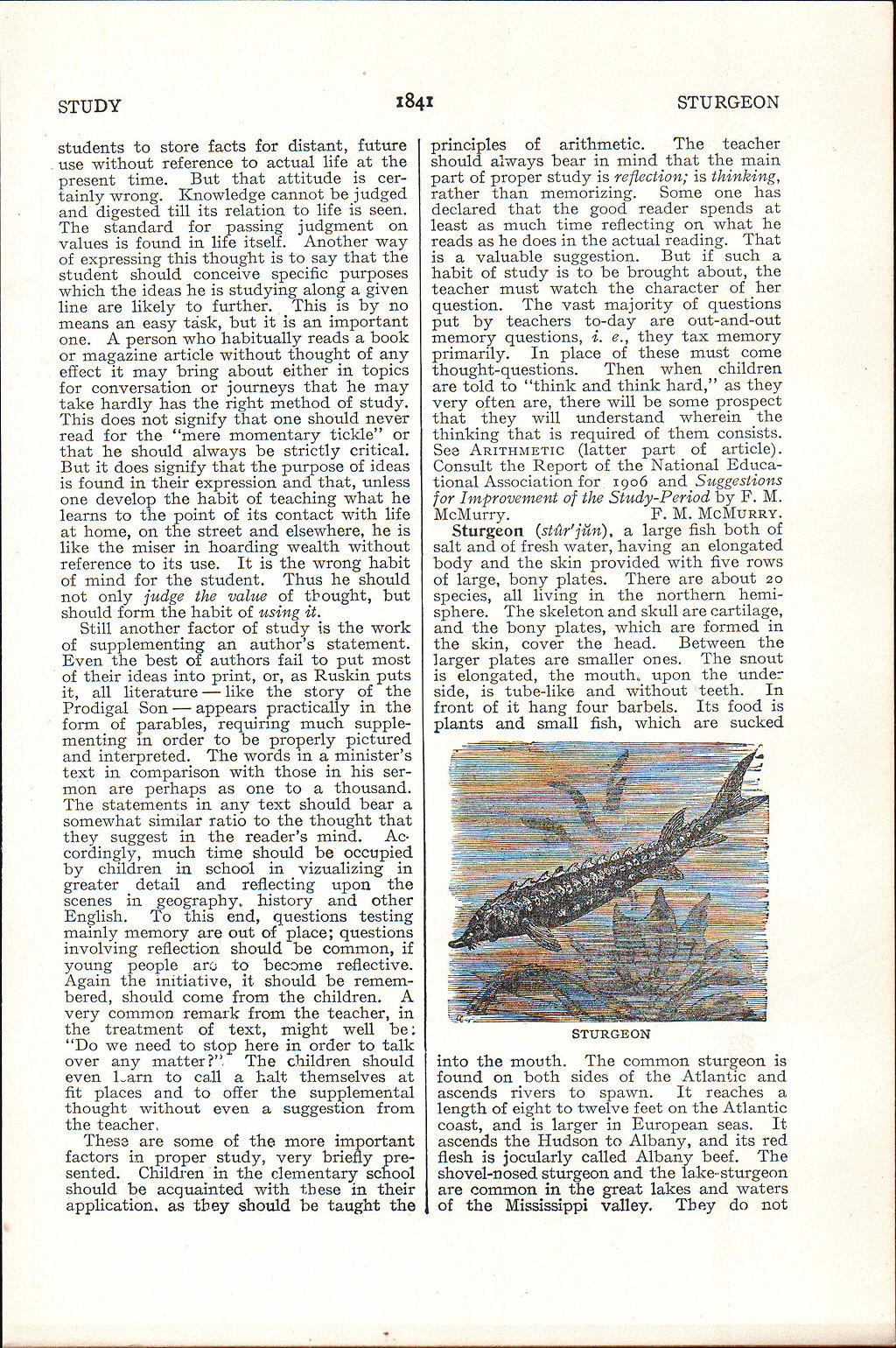STUDY
1841
STURGEON
students to store facts for distant, future use without reference to actual life at the present time. But that attitude is certainly wrong. Knowledge cannot be judged and digested till its relation to life is seen. The standard for passing judgment on values is found in life itself. Another way of expressing this thought is to say that the student should conceive specific purposes which the ideas he is studying along a given line are likely to further. This is by no means an easy task, but it is an important one. A person who habitually reads a book or magazine article without thought of any effect it may bring about either in topics for conversation or journeys that he may take hardly has the right method of study. This does not signify that one should never read for the "mere momentary tickle" or that he should always be strictly critical. But it does signify that the purpose of ideas is found in their expression and that, unless one develop the habit of teaching what he learns to the point of its contact with life at home, on the street and elsewhere, he is like the miser in hoarding wealth without reference to its use. It is the wrong habit of mind for the student. Thus he should not only judge the value of tr ought, but should form the habit of using it.
Still another factor of study is the work of supplementing an author's statement. Even the best of authors fail to put most of their ideas into print, or, as Ruskin puts it, all literature — like the story of the Prodigal Son — appears practically in the form of parables, requiring much supplementing in order to be properly pictured and interpreted. The words in a minister's text in comparison with those in his sermon are perhaps as one to a thousand. The statements in any text should bear a somewhat similar ratio to the thought that they suggest in the reader's mind. Accordingly, much time should be occupied by children in school in vizualizing in greater detail and reflecting upon the scenes in geography, history and other English. To this end, questions testing mainly memory are out of place; questions involving reflection should be common, if young people arc to become reflective. Again the initiative, it should be remembered, shoxild come from the children. A very common remark from the teacher, in the treatment of text, might well be: "Do we need to stop here in order to talk over any matter?'* The children should even Larn to call a halt themselves at fit places and to offer the supplemental thought without even a suggestion from the teacher..
These are some of the more important factors in proper study, very briefly presented. Children in the elementary school should be acquainted with these in their application, as they should be taught the
principles of arithmetic. The teacher should always bear in mind that the main part of proper study is reflection; is thinking, rather than memorizing. Some one has declared that the good reader spends at least as much time reflecting on what he reads as he does in the actual reading. That is a valuable suggestion. But if such a habit of study is to be brought about, the teacher must watch the character of her question. The vast majority of questions put by teachers to-day are out-and-out memory questions, i. e., they tax memory primarily. In place of these must come thought-questions. Then when children are told to "think and think hard," as they very often are, there will be some prospect that they will understand wherein the thinking that is required of them consists. See ARITHMETIC (latter part of article). Consult the Report of the National Educational Association for 1906 and Suggestions for Improvement of the Study-Period by P. M. McMurry. F. M. McMuRRY.
Sturgeon (stur'juri), a large fish both of salt and of fresh water, having an elongated body and the skin provided with five rows of large, bony plates. There are about 20 species, all living in the northern hemisphere. The skeleton and skull are cartilage, and the bony plates, which are formed in the skin, cover the head. Between the larger plates are smaller ones. The snout is elongated, the mouth* upon the under side, is tube-like and without teeth. In front of it hang four barbels. Its food is plants and small fish, which are sucked
STURGEON
into the mouth. The common sturgeon is found on ^both sides of the Atlantic and ascends rivers to spawn. It reaches a length of eight to twelve feet on the Atlantic coast, and is larger in European seas. It-ascends the Hudson to Albany, and its red flesh is jocularly called Albany beef. The shovel-nosed sturgeon and the lake-sturgeon are common in the great lakes and waters of the Mississippi valley, Tbey do not
